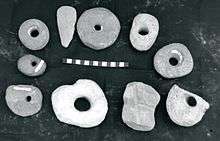Sierra Leone National Museum
The Sierra Leone National Museum is the national museum of Sierra Leone. The museum is located at the junction of Siaka Stevens Street and Pademba Road in central Freetown, the capital of the country.[1][2]

The museum's origin dates back to before Sierra Leone's independence. The Monuments and Relics Commission, chaired by retired Creole doctor M. C. F. Easmon, was set up by a 1946 ordinance "to provide for the preservation of Ancient, Historical, and Natural Monuments, Relics, and other objects of Archaeological, Ethnographical, Historical or other Scientific Interest".[3] In 1953, Governor Sir Robert Hall encouraged the formation of the Sierra Leone Society and then challenged its members, mainly colonial expatriates and the Creole elite of the city,[4] to establish a museum.[3] In 1955, he offered the old Cotton Tree Telephone Exchange as a temporary location for the museum for a nominal rent.[3] The place was gradually refurbished, and the Sierra Leone Museum[3] or Museum of the Sierra Leone Society[4] was officially opened on 10 December 1957 by Chief Minister Sir Milton Margai.[3]
Sierra Leone gained its independence from Britain in 1961. The Sierra Leone Society ceased to exist in 1964,[3] but the Monuments and Relics Commission was granted the authority to "acquire, maintain and administer the Sierra Leone Museum founded by the Sierra Leone Society" in 1967, the year it became the national museum.[3]
The government has rarely provided much support, and the museum still occupies its original, "temporary" location.[1] The German embassy paid for an extension, which opened in 1987, marking the bicentennial of the founding of Freetown.[1] The acting chief curator is Josephine Kargbo.[1][4]
In 2013, the museum displayed the only known photograph of the Temne guerrilla leader Bai Bureh, who in 1898 started a war against British rule.[5]
University College London's "Reanimating Cultural Heritage: Digital Repatriation, Knowledge Networks and Civil Society Strengthening in Post-Conflict Sierra Leone" project, in conjunction with the Sierra Leonean Ministry of Cultural Affairs, the National Museum and other organizations and museums, has digitised 2000 objects from the museum, along with numerous other objects from other sources.[6][7]
References
- "Sierra Leone National Museum". sierraleoneheritage.org. Retrieved 15 August 2014.
- "Sierra Leone National Museum". Google+. Retrieved 15 August 2014.
- "A Brief History of Sierra Leone National Museum". sierraleoneheritage.org.
- "Africa Programme: Sierra Leone". British Museum.
- "Bai Bureh's Grave". Monuments and Relics Commission.
- "Reanimating cultural heritage in Sierra Leone". University College London.
- "Reanimating cultural heritage in Sierra Leone". Arts and Humanities Research Council.
External links

- "Reanimating Cultural Heritage" project website